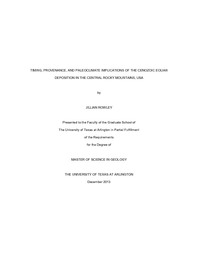
ATTENTION: The works hosted here are being migrated to a new repository that will consolidate resources, improve discoverability, and better show UTA's research impact on the global community. We will update authors as the migration progresses. Please see MavMatrix for more information.
Show simple item record
| dc.contributor.author | Rowley, Jillian | en_US |
| dc.date.accessioned | 2014-03-12T23:48:59Z | |
| dc.date.available | 2014-03-12T23:48:59Z | |
| dc.date.issued | 2014-03-12 | |
| dc.date.submitted | January 2013 | en_US |
| dc.identifier.other | DISS-12464 | en_US |
| dc.identifier.uri | http://hdl.handle.net/10106/24076 | |
| dc.description.abstract | This study applies detrital zircon U-Pb geochronology and sandstone petrography to constrain the timing and provenance of Cenozoic eolian sandstone in the central Rocky Mountains. Four samples, collected at the transition to eolian deposition along a west-east transect, have maximum depositional ages of 35.9±0.7 Ma, 35.4±2.0 Ma, 33±0.9 Ma, and 30±1.0 Ma, suggesting the transition initiated during the latest Eocene-earliest Oligocene and became younger eastward. A total of 766 zircon grains consist of a 17-44 Ma population, derived from the distal ignimbrite flare-up in western and southwestern North America, and a population older than 45 Ma, recycled from local Laramide uplifts. Sandstone petrography results indicate detritus from the distal ignimbrite flare-up and local Laramide uplifts. The transition to eolian deposition could represent regional drying caused by both global cooling due to initiation of Antarctic glaciation and the development of rain shadow in the central Rocky Mountains due to regional uplift. | en_US |
| dc.description.sponsorship | Fan, Majie | en_US |
| dc.language.iso | en | en_US |
| dc.publisher | Geology | en_US |
| dc.title | Timing, Provenance, And Paleoclimate Implications Of The Cenozoic Eolian Deposition In The Central Rocky Mountains, USA | en_US |
| dc.type | M.S. | en_US |
| dc.contributor.committeeChair | Fan, Majie | en_US |
| dc.degree.department | Geology | en_US |
| dc.degree.discipline | Geology | en_US |
| dc.degree.grantor | University of Texas at Arlington | en_US |
| dc.degree.level | masters | en_US |
| dc.degree.name | M.S. | en_US |
Files in this item
- Name:
- Rowley_uta_2502M_12464.pdf
- Size:
- 211.9Mb
- Format:
- PDF
This item appears in the following Collection(s)
Show simple item record


